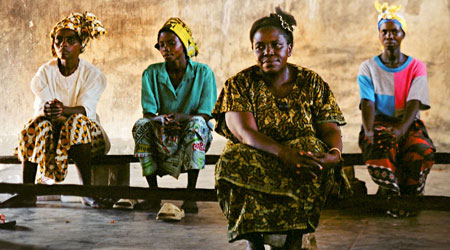invisibles
Shown at the 2007 Tribeca Film Festival
Directors: Isabel Coixet (Letters to Nora); Wim Wenders (Invisible Crimes); Fernando León de Aranoa (Good Night, Ouma); Mariano Barroso (Bianca’s Dream); and Javier Corcuera (The Voice of the Stones).
Reviewed by Julia Sirmons
For people living in privileged societies, the impulse to shield one’s self from the horrors and injustices perpetrated in other, less fortunate, areas of the world is all too common. The news is so relentless, so horrifying, that looking away seems to be a question of self-preservation.
It is this willful ignorance that Invisibles, a film co-produced by Oscar-nominated actor Javier Bardem (Before Night Falls) and the humanitarian organization Doctors Without Borders, seeks to eradicate. The result is a powerful testament to the overlooked suffering in the world, as well as an inspiring tribute to the people who decline to ignore what the rest of the world refuses to see.
Invisibles is comprised of five different segments, each shot by a different director and each focusing on a different humanitarian issue. The best films in Invisibles hit a perfect balance between cinematic interest and altruistic passion. The most fascinating and compelling is Wim Wenders’ Invisible Crimes, which records the testimony of women raped by Maï-Maï rebels in the Democratic Republic of Congo.
Standing before a blackboard in a rural schoolhouse, the women recount their stories with an eerie calmness that belies the horrific ideals they have experienced. At a key moment in her narrative, each woman will vanish from the screen while her voice continues speaking. It’s a simple technique, but one that powerfully and economically conveys the effect of rape on a victim’s psyche.
In Isabel Coixet’s Letters to Nora (Cartas a Nora), the protagonist details her husband’s losing battle with Chagas disease -- a parasitic illness that runs rampant in many parts of South America – in letters to her sister Nora. Nora supports her sister’s family by working in Spain. Her own daughter also died of Chagas disease. All ambient sound is muted, and against images of the protagonist – who remains unnamed until the final scene – going about the business of everyday life, her voice-overs express her stifled rage at the medical and pharmaceutical industry’s refusal to help her or her family.
In the Letters’ credits, we learn that no laboratory in the world is researching a cure for Chagas disease. (Since it primarily affects poor communities in Third World countries, big pharmaceutical companies don’t consider research into Chagas a profitable enterprise.) Coixet’s cinematic technique beautifully portrays the feelings of invisibility and insignificance of those who fall through the cracks of the system of humanitarian aid.
The next segment, Good Night, Ouma (Buenas noches, Ouma), directed by Fernando León de Aranoa, tells the story of young Ugandan boys kidnapped and forced to fight in their country’s ongoing civil war. The interviews with the former child soldiers are poignant and haunting, and the stories of the activists trying to protect other children from the same fate are genuinely inspiring. However, the film’s emotional content suffers slightly from poor editing and would benefit from a bit more narrative focus.
Mariano Barroso’s entry, Bianca’s Dream (Los sueños de Bianca) takes an interesting approach to the issue of the pharmaceutical industry’s negligence in dealing with sleeping sickness, which is annihilating populations in Western Africa. Barroso combines black-and-white footage of two non-government organization (NGO) workers arguing with a Scrooge-like CEO about working to improve anti—sleeping sickness drugs to rural communities. This footage is intercut with color shots of an ailing woman crawling along a dirt road seeking treatment for the disease. The contrast is effective, but a little heavy-handed, and ultimately does victims of sleeping sickness a disservice by not devoting enough attention to the woman’s side of the story.
Invisibles’ final segment, The Voice of the Stones (La voz de piedras), directed by Javier Corcuera, is a more straightforward documentary, but an incredibly well crafted and moving one. Voice follows a resolute group of displaced Colombian peasants determined to leave the city and reclaim their homeland. Corcuera manages to tell their story with simple passion and dignity, admirably demonstrating their determination to start over from scratch and return to their ancestral way of life. Interviews with the émigrés are interspersed with folk songs and dances commemorating their rural heritage and emphasizing their passion for preserving the way of life of their ancestors. Their conviction, in spite of bureaucratic corruption and scheming, to live their lives the way they choose is truly inspiring.
While the cinematic mastery exhibited in each of the segments in Invisibles varies, every single one of them opens the viewer’s eyes to appalling humanitarian and medical crises that the mainstream media has indeed rendered invisible. The mere possibility that this film could make such suffering visible to the Western world and encourage its audience to take action on behalf of those who have no voice makes Invisibles essential viewing.

